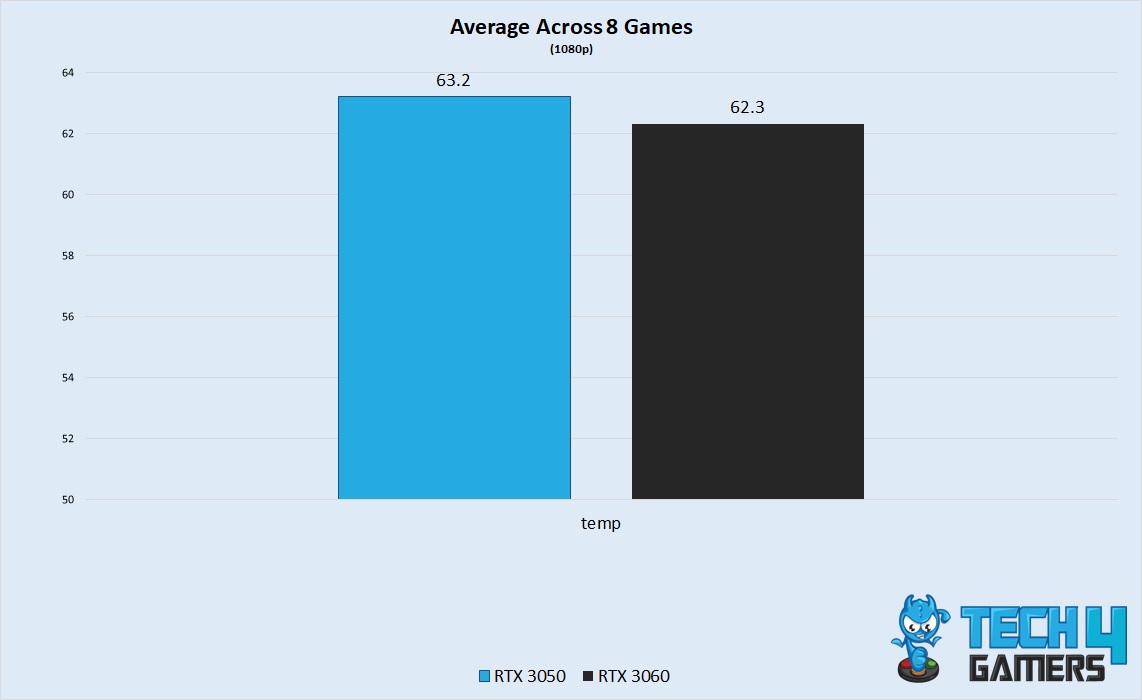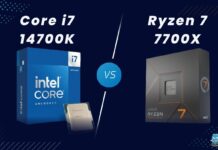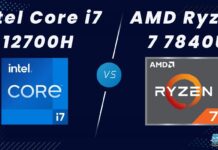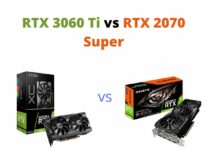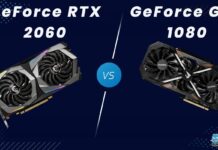In the RTX 3050 vs RTX 3060 comparison, we will test the real-world performance of both these cards to demonstrate the performance of Nvidia cards in the lower-end market segment. Both cards will be tested in several games at high to ultra settings.
Key Takeaways
- In our tests at 1080p, the RTX 3060 performs about 41% better than the RTX 3050.
- Our tests showed the power consumption of the RTX 3050 to be around 45% lower than that of the RTX 3060.
- The RTX 3050 is about 32% cheaper than the RTX 3060.
RTX 3050 Vs RTX 3060
Comparison Table
| Technical Specs | NVIDIA RTX 3060 | NVIDIA RTX 3050 |
| GPU | GA106 | GA106 |
| Architecture | Ampere | Ampere |
| Transistors | 12,000 million | 12,000 million |
| CUDA Cores | 3584 | 2560 |
| Tensor Cores | 112 | 80 |
| RT Cores | 28 | 20 |
| TMUs | 112 | 80 |
| ROPs | 48 | 32 |
| Memory Bus | 192-bit | 128-bit |
| Memory Speed | 360.0 GB/s | 224.0 GB/s |
| L2 Cache | 3 MB | 2 MB |
| MSRP | $329 | $250 |
| Best Variants | RTX 3060 | RTX 3050 |
Architectural Differences
- TDP: RTX 3060 has a TDP of 170 Watts, while RTX 3050 has a lower TDP of 130 Watts, indicating better power efficiency for the RTX 3050.
- Clock Speeds: Both cards share the same boost clock of 1777 MHz, but RTX 3050 has a higher base clock of 1552 MHz compared to RTX 3060’s 1320 MHz.
- Processing Nodes: Both use the 8nm Ampere architecture, offering good power efficiency and performance.
- VRAM: RTX 3060 has 12GB of GDDR6 memory, while RTX 3050 has 8GB, providing more VRAM for the RTX 3060.
These differences impact power consumption, performance in less demanding scenarios, and VRAM capacity.
Also Read: RTX 3050 Vs 2060
Gaming Benchmarks
Performance might not always be linked to the architectural differences between cards, which is why we have set up a test bench to test our two components, the specifications of which are listed below:
- OS: Windows 11
- CPU: Intel Core i5-13600K
- Motherboards: ASRock Z790 Taichi Lite Motherboard
- RAM: Kingston Fury Renegade RGB DDR5 32GB 7200MHz
- SSD: Sabrent Rocket 4 Plus 1TB NVMe SSD
- PSU: Enermax Revolution D.F. X 1050W
- CPU Cooler: Noctua NH-L9x65 chromax.black CPU Air Cooler
The Last Of Us (High Settings)
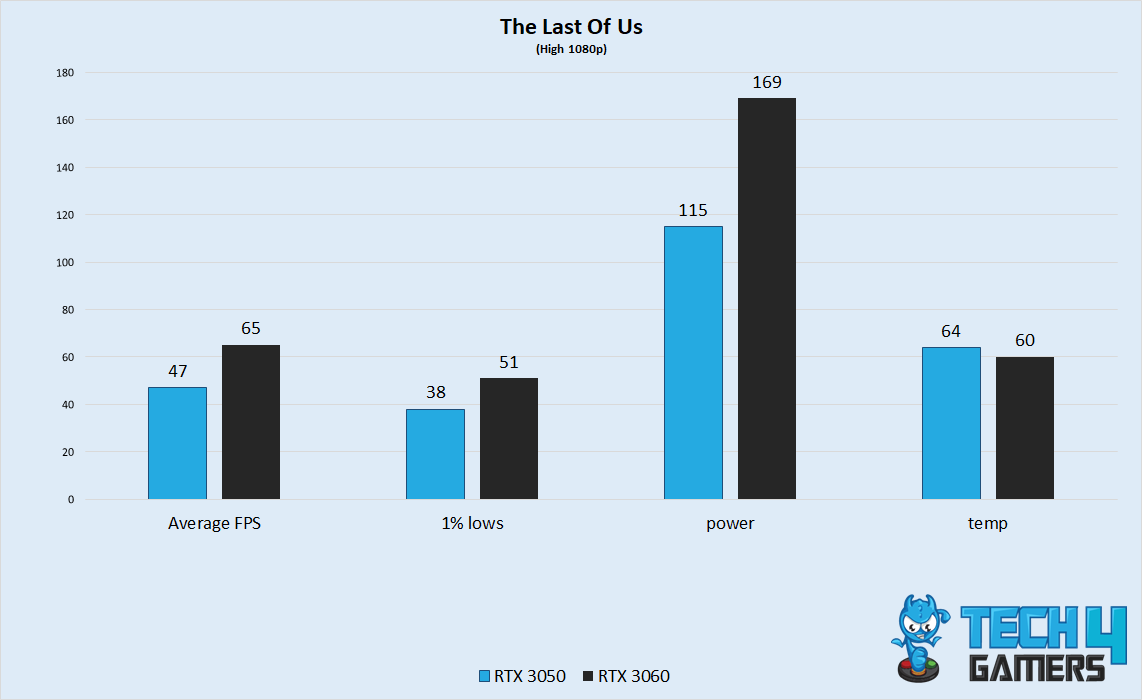
- The honor of being the first game in the benchmark tests goes to The Last Of Us, a particularly demanding game to run, even for high-end GPUs. In this game, the RTX 3050 averaged 47 FPS, whereas the RTX 3060 had a noticeably smoother performance of 65 FPS.
- The 1% lows also provided a better experience on the RTX 3060. It had 1% lows of about 51 FPS, while the RTX 3050 managed to get about 38 FPS.
- Power consumption was, as expected, much lower on the RTX 3050. It pulled 115 watts from the wall, whereas the RTX 3060 consumed 169 watts.
- Temperatures in this game were much higher on the weaker card. The RTX 3050 had a peak temperature of 64,°C whereas the RTX 3060 was noticeably cooler with a peak temperature of 60°C.
Atomic Heart (Max Settings)
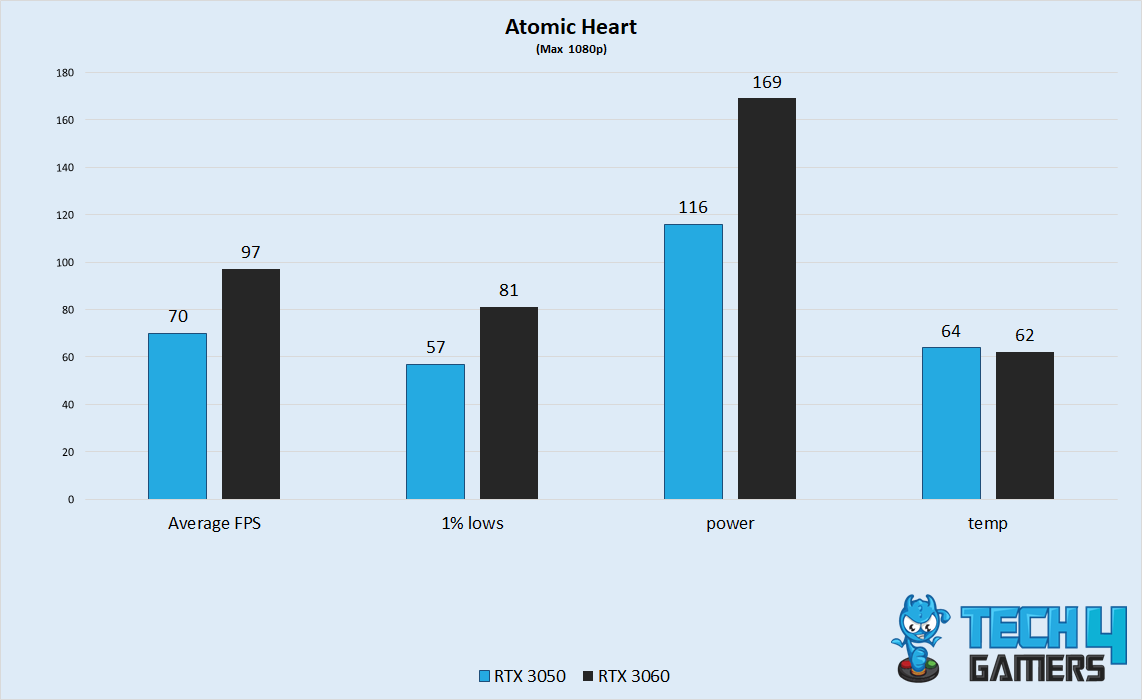
- When running Atomic Heart at maximum settings and 1080p resolution, the RTX 3050 and the RTX 3060 showcased impressive performance. The RTX 3060 achieved a higher average of around 97 FPS, surpassing the RTX 3050’s average of 70 FPS.
- Regarding 1% lows, the RTX 3050 disappointed us with weak results while the RTX 3060 was running comfortably, outputting 81 FPS compared to the RTX 3050’s 57 FPS.
- Power consumption was noticeably different between the two cards, with the RTX 3050 consuming 116 watts and the RTX 3060 consuming a higher 169 watts.
- Regarding temperatures, the RTX 3050 reached a peak of 64°C, while the RTX 3060 maintained a slightly lower peak temperature of 62°C.
Also Check: RTX 3050 Vs RX 6600
Dead Space Remake (Ultra Settings)
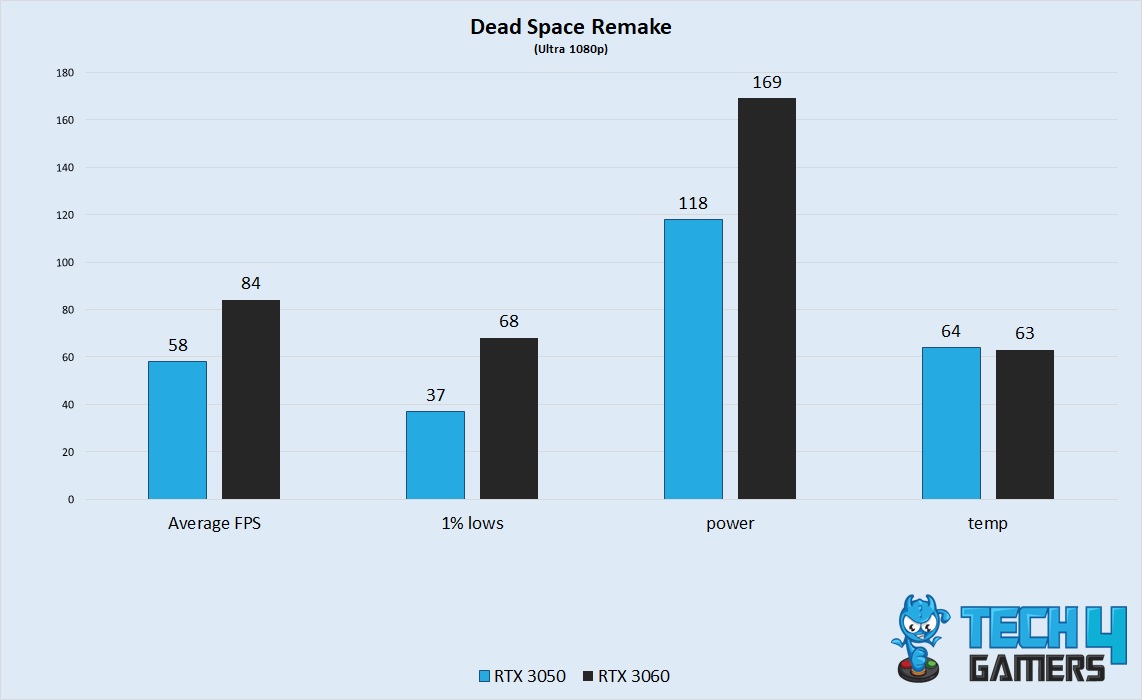
- In our test of the Dead Space Remake, the RTX 3060 showcased commendable performance at ultra settings and 1080p resolution, whereas the 3050 was a bit of a letdown. The RTX 3060 offered a significant boost in average frame rate, reaching around 84 FPS, compared to the RTX 3050’s average of 58 FPS.
- When we looked at the at 1% lows, the RTX 3060 demonstrated a substantial improvement over the RTX 3050, delivering 68 FPS compared to the RTX 3050’s 37 FPS.
- Switching gears to power consumption, the RTX 3050 drew 118 watts, while the RTX 3060 consumed a higher 169 watts. The RTX 3060’s higher power consumption is expected, given its superior performance.
- Both cards maintained similar temperature levels during gameplay, with the RTX 3050 peaking at 64°C and the RTX 3060 slightly lower at 63°C.
Cyberpunk 2077 (High Settings)
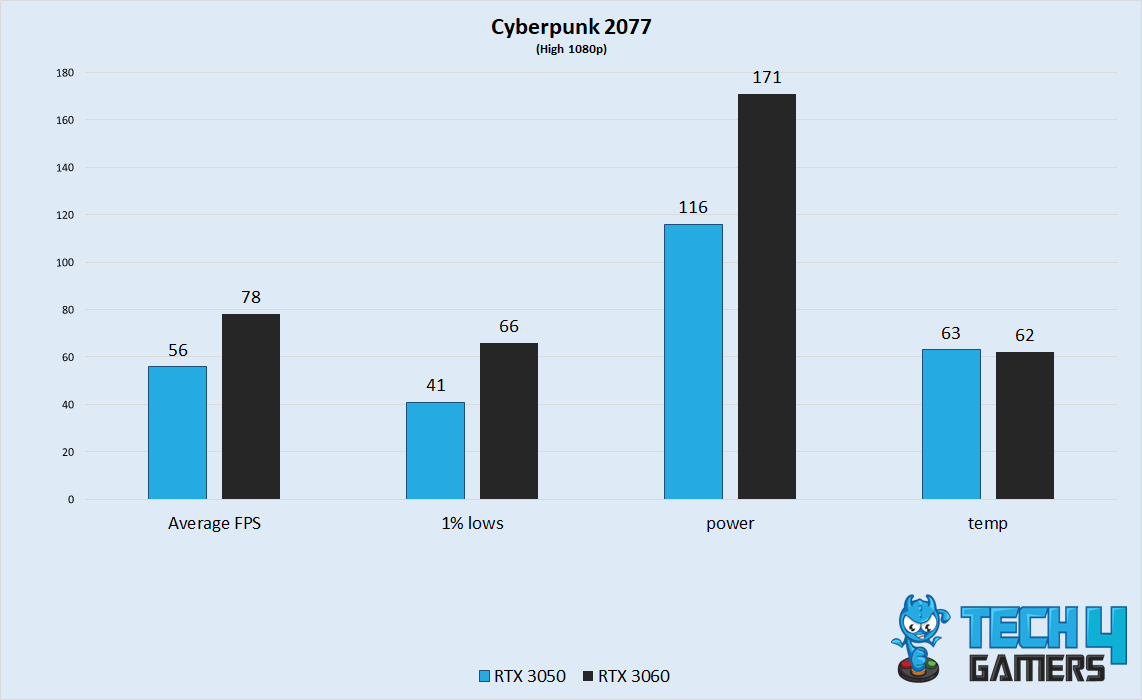
- Our test of Cyberpunk 2077 with maxed-out graphics had the RTX 3050 and RTX 3060 demonstrating solid performance. The RTX 3060 outperformed the RTX 3050 with an average of 78 FPS compared to the RTX 3050’s 56 FPS.
- The reported 1% lows were not great on the lower-tier card. The RTX 3060 showcased smoother gameplay with 66 FPS, surpassing the RTX 3050’s 41 FPS. The above 60 FPS experience given by the RTX 3060 always ensures a much smoother experience than the RTX 3050.
- Regarding power consumption, the RTX 3050 drew 116 watts, while the RTX 3060 had a slightly higher power draw of 171 watts.
- Both graphics cards maintained similar temperature levels during the gameplay session, with the RTX 3050 peaking at 63°C and the RTX 3060 at 62°C. The difference in thermals in this test can be marked up to the margin of error.
Also Check: AMD RX 6700 XT Vs Nvidia RTX 3060
Sons Of The Forrest (High Settings)
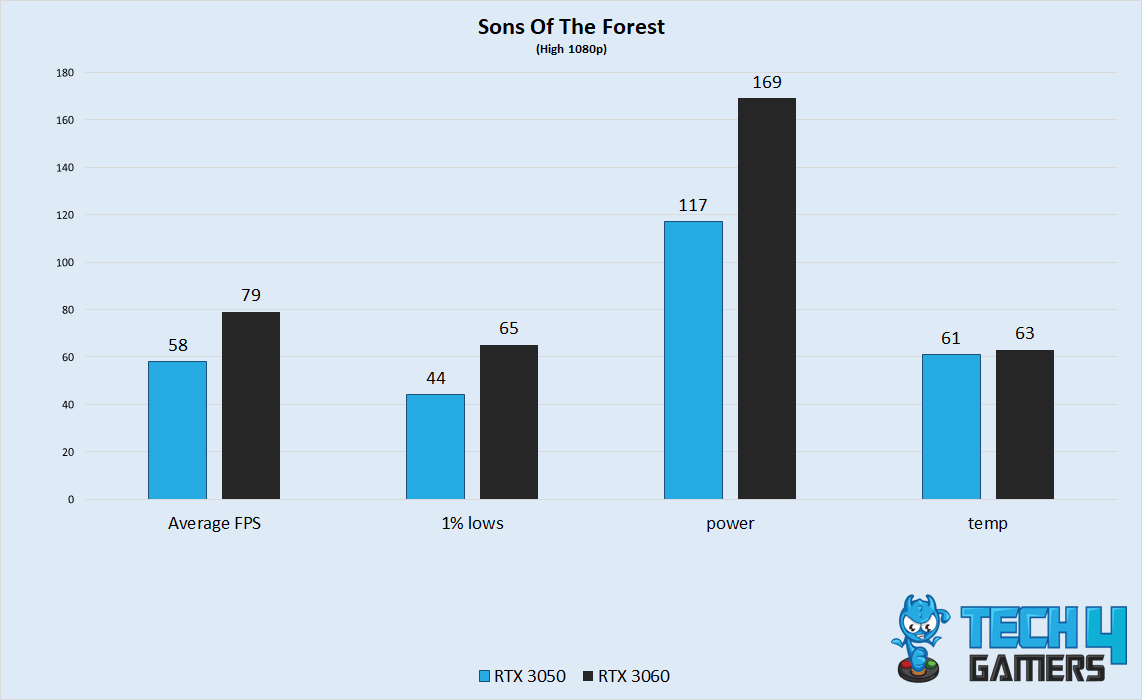
- In our run of Sons Of The Forest, the RTX 3060 delivered an impressive performance at high settings and 1080p resolution, outperforming the RTX 3050. With an average of 79 FPS, the RTX 3060 showcased smoother gameplay compared to the RTX 3050’s average of 58 FPS.
- When examining the 1% lows, the RTX 3060 exhibited a significant improvement, providing a minimum frame rate of 65 FPS, while the RTX 3050 lagged with 44 FPS.
- Coming to power consumption, the RTX 3050 drew 117 watts, while the RTX 3060 consumed 169 watts.
- Both graphics cards maintained relatively similar temperature levels during gameplay, with the RTX 3050 peaking at 61°C and the RTX 3060 slightly higher at 63°C.
Red Dead Redemption 2 (High Settings)
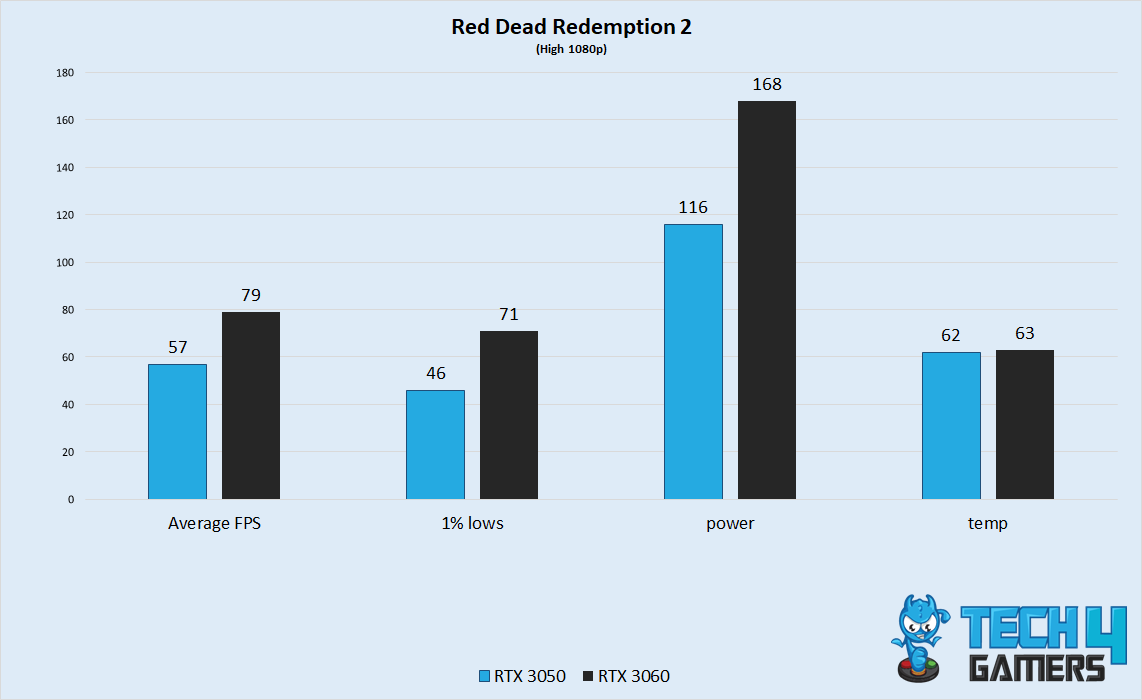
- When we ran RDR2 on both our GPUs, there were some noticeable differences between our cards. The RTX 3060 stood out with its impressive average of 79 FPS, outperforming the RTX 3050’s average of 57 FPS.
- When considering the 1% lows, which represent minimum frame rates, the RTX 3060 exhibited a significant leap, delivering 71 FPS compared to the RTX 3050’s 46 FPS. This indicates much smoother and more consistent gameplay on the RTX 3060.
- In terms of power consumption, the RTX 3050 drew 116 watts, while the RTX 3060 consumed a slightly higher 168 watts.
- Both graphics cards maintained similar temperature levels during gameplay, with the RTX 3050 peaking at 62°C and the RTX 3060 at 63°C. Once again, these differences can be chalked up to the margin of error.
Similar Comparisons: RX 6600 XT Vs RTX 3050
Resident Evil 4 Remake (High Settings)
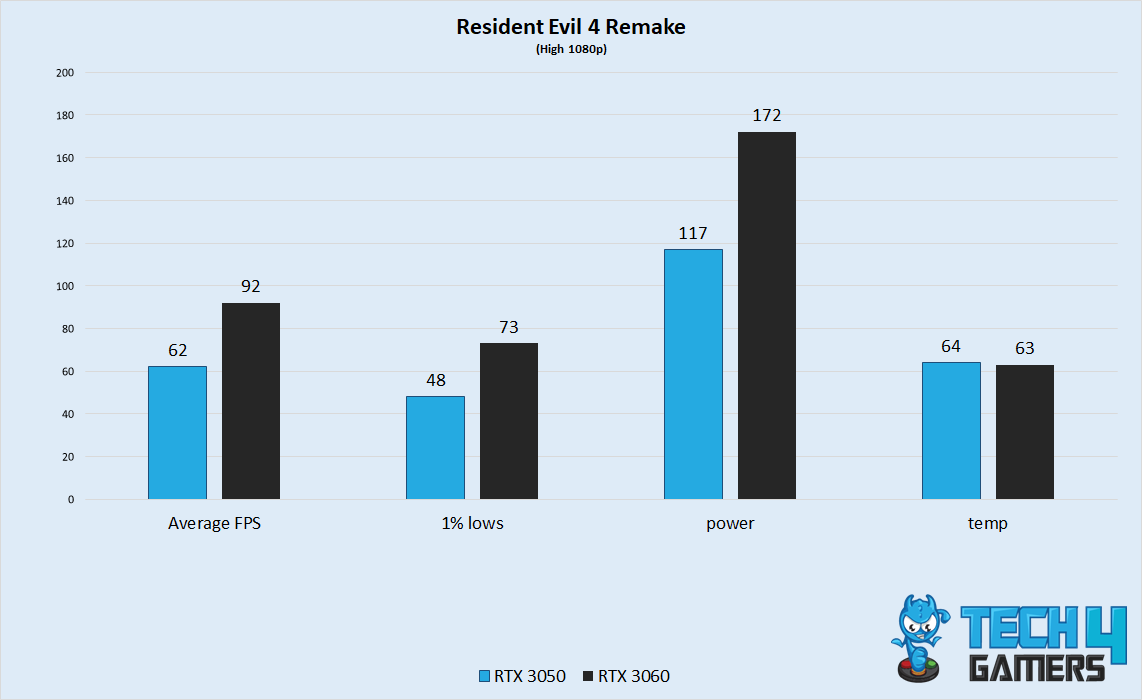
- Our walkthrough of Resdient Evil 4 reaffirmed the differences in performance between these cards. The RTX 3060 stood out with its remarkable average of 92 FPS, surpassing the RTX 3050’s average of 62 FPS.
- Diving into the 1% lows, representing the minimum frame rates, the RTX 3060 exhibited a substantial improvement with 73 FPS, whereas the RTX 3050 lagged at 48 FPS. This translates to smoother and more consistent gameplay on the RTX 3060.
- Regarding power consumption, the RTX 3050 drew 117 watts, while the RTX 3060 required a slightly higher 172 watts. Considering its superior performance, this higher power demand on the RTX 3060 is expected.
- Both graphics cards maintained comparable temperature levels during gameplay, with the RTX 3050 peaking at 64°C and the RTX 3060 at 63°C.
Hogwarts Legacy (Ultra Settings)
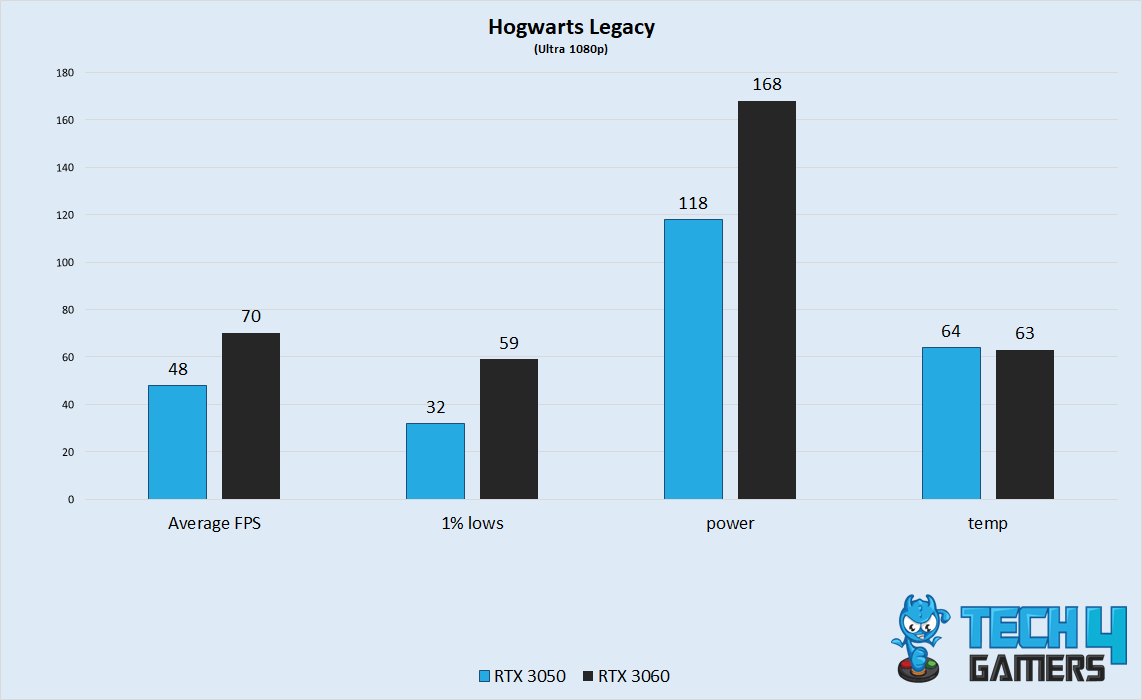
- The RTX 3050 did not run great in our test of Hogwarts Legacy. However, it was the RTX 3060 that truly shined, delivering an impressive average of 70 FPS, outperforming the RTX 3050’s average of 48 FPS.
- Delving into the 1% lows, which represent the minimum frame rates, the RTX 3060 exhibited a significant advantage with 59 FPS, providing better gameplay than the RTX 3050’s 32 FPS.
- In terms of power consumption, the RTX 3050 drew 118 watts, while the RTX 3060 required a slightly higher 168 watts.
- Both graphics cards maintained similar temperature levels, with the RTX 3050 peaking at 64°C and the RTX 3060 at 63°C. A temperature difference this small can be, once again, marked up to the margin of error.
Also Read: GTX 1650 vs RTX 3050
Overall Performance
Frame Rate
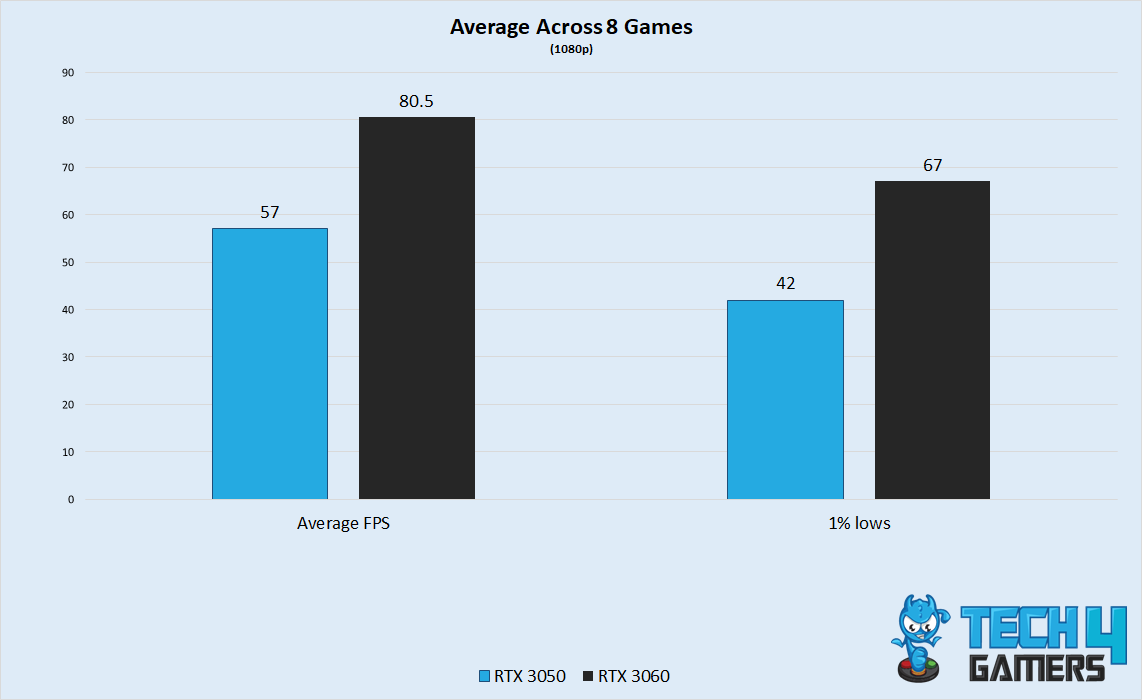
- RTX 3050: Averages 57 FPS with a 1% low of 42 FPS.
- RTX 3060: Takes the lead with an average of 80.5 FPS and a 1% low of 67 FPS.
The RTX 3060 offers significantly higher average and 1% low frame rates, providing a smoother gaming experience. Adjusting settings and enabling DLSS can further enhance performance on both cards, but the RTX 3060 maintains its performance advantage.
Check out our list of the best GPU overclocking software if you wish to squeeze out all the performance your GPU offers.
Power Consumption
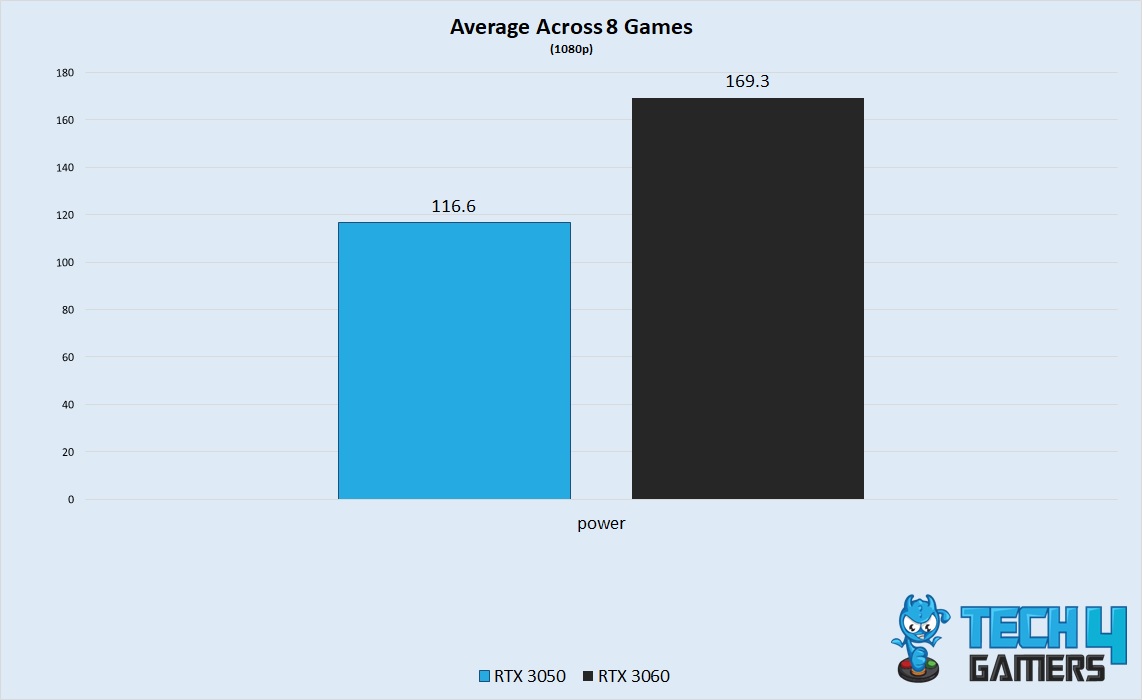
Power Consumption:
- RTX 3050: Averages 116.6 watts.
- RTX 3060: Consumes more power, averaging 169.3 watts.
Performance per Watt:
- RTX 3050: Achieves 0.488 frames/watt.
- RTX 3060: Slightly lower at 0.475 frames/watt.
While the RTX 3060 consumes more power, it offers significantly better performance. The RTX 3050 has a lower power draw, which may allow for a smaller power supply and potentially lower long-term power costs.
If you want to match your power supply to the power target of the rest of your computer, read our article on how many watts a gaming PC consumes.
Also Read: RX 5700 XT Vs RTX 3060
Temperatures
- Regarding temperature, the RTX 3050 reached an average peak temperature of 63.2°C in our tests, while the RTX 3060 maintains a slightly lower average temperature of 62.3°C. These temperature readings indicate effective cooling solutions for both graphics cards, ensuring stable and reliable performance during extended gaming sessions.
- In most games, the temperatures between these cards went back and forth a degree or two, which indicates identical thermal performance in most modern titles. Still, the thermals were different by a significant margin in some games, sometimes better for the RTX 3050 and sometimes better for the RTX 3060.
Temperatures are very important to keep in check if you want your GPU to reach its maximum lifespan. If you want to learn about safe GPU idle temperatures, read our guide on the topic.
Performance Per Dollar
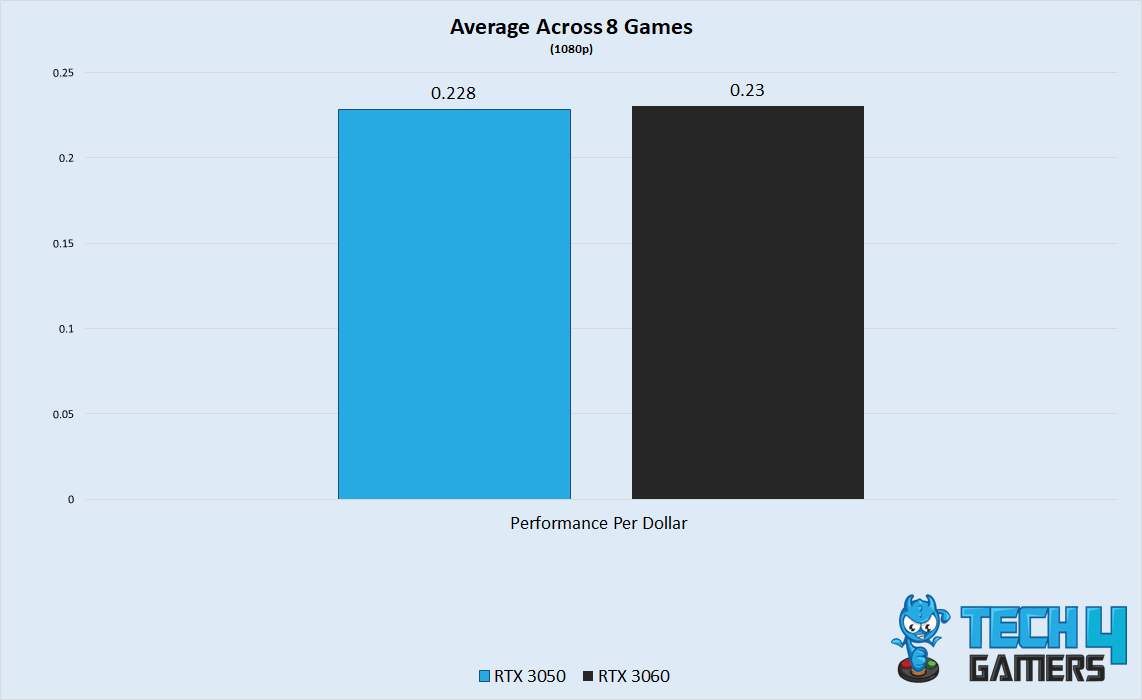
- The RTX 3050 achieves a value of 0.228 frames/dollar, while the RTX 3060 offers a slightly higher value of 0.23 frames/dollar.
- This suggests that the RTX 3060 provides slightly better performance relative to its cost, making it a more cost-effective choice for gamers seeking high-quality visuals and smooth gameplay.
Also Check: RTX 3060 Vs 3060 Ti
If you want to learn the current market cost of your computer, check out our valuation guide.
Price And Availability
- Being entry-level GPUs, both the GPUs in this comparison come in at a very affordable price. The RTX 3050 will cost you $250 if you buy at MSRP. The RTX 3060 is a different pricing tier at $330 but affordable nonetheless.
- As for availability, you should be able to find both these cards at any brick-and-mortar store you choose. The age of these cards also allows you to snag them for cheap on sites like eBay, further lowering their costs.
What We Recommend
The distinction between the demographics of these two cards seems convoluted at first, but it becomes very apparent after you do some digging.
- The RTX 3060 is the better card overall. It has 41% better performance than the RTX 3050 at only 32% more cost.
- We strongly recommend getting this card over the RTX 3050 for these reasons if your budget can stretch far enough.
- Despite all this, the RTX 3050 does not provide a bad deal either. It has the same GPU die as the 3060, albeit with fewer cores and lesser VRAM.
- It also has a lower power draw and smaller size than the 3060, making it ideal for a low-power small form factor build.
Similar Comparisons: RX 6600 XT Vs RTX 3060
Pros And Cons
| RTX 3050 | RTX 3060 | ||
| Pros | Cons | Pros | Cons |
| It is generally more budget-friendly than higher-end graphics cards, making it accessible to a wider range of users. | Typically comes with 8GB of VRAM, which causes worse performance in certain modern games. | The RTX 3060 offers excellent performance at 1080p and 1440p resolutions, delivering smooth gaming experiences in most titles. | While the RTX 3060 can handle some games at 4K resolution, it may not consistently achieve high frame rates or maximum settings in more graphically demanding titles. |
| The lower power budget and sleeker design of the RTX 3080 make it ideal for small form factor builds. | Performs noticeably worse than the RTX 3060 at 1080p. | The RTX 3060 usually comes with 12GB of VRAM, providing ample memory for high-resolution textures and demanding applications. | The RTX 3060 can consume more power compared to its predecessor, which may require a sufficiently powerful power supply in your system. |
FAQs
The RTX 3050 and RTX 3060 support real-time ray tracing, but being lower-end cards, the experience is not very enjoyable.
Turning on DLSS gives you a free boost in performance with minimal degradation to visual quality.
No, DLSS 3 and the accompanying frame generation is locked to the RTX 40 series of cards.
More From RTX 3060
- RTX 3060 Vs GTX 1660 Ti
- RTX 3060 Vs RTX 3070
- 2070 Super Vs 3060
- RTX 2060 Vs 3060
- RTX 3060 vs GTX 1080
Thank you! Please share your positive feedback. 🔋
How could we improve this post? Please Help us. 😔
[Comparisons Expert]
Abdemanaf is a skilled creative writer who has been honing his craft since 2011. While initially working in different fields, he found a passion for technology and has been exploring the tech world since early 2015. Over the years, he has developed an in-depth knowledge of the latest tech trends and product offerings by various companies.
Abdemanaf’s writing reflects his analytical mindset and ability to think critically. He has a knack for breaking down complex technical information into easily digestible pieces, making his articles engaging and accessible to readers from all backgrounds. In February 2022, he joined Tech4Gamers as a blog and product comparison writer, where he has been able to hone his skills further.
As a writer, Abdemanaf is dedicated to staying up-to-date with the latest technological advancements and trends, enabling him to provide readers with the most relevant and accurate information. He is always eager to learn more and is constantly seeking new challenges to improve his skills.
Get In Touch: manaf@tech4gamers.com


 Threads
Threads